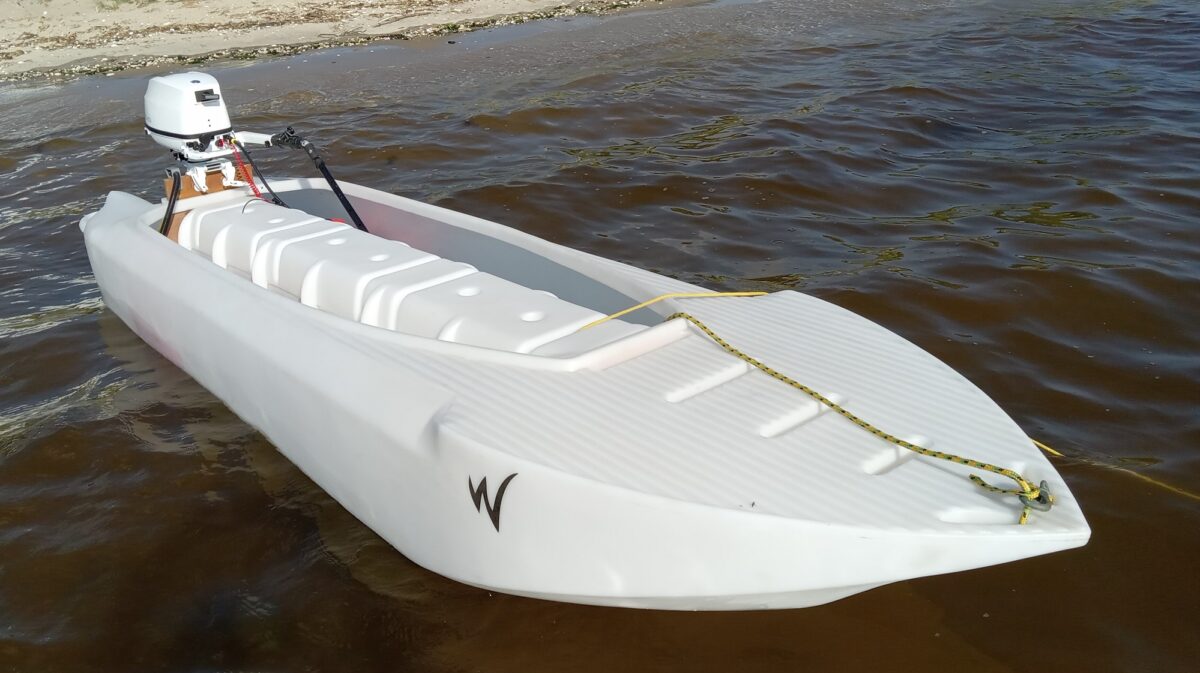What Happens When You Load a W Fishing Kayak?
The illustration below shows a W500 kayak in three load points –
The left image shows it unloaded.
The image in the middle shows it loaded with around 200 lbs (91 kg). The load is distributed evenly front and back, so the kayak stays level, which offers optimal speed and control. The draft is shallow.
This load results in a slight splaying of the hulls, and no problem at all. Flex is built into the W design.

The image on the right shows the kayak loaded with around 360 lb (163 kg), which is the maximum load recommended for it. Assuming the load is distributed evenly front and back, the kayak stays level, and it’s still fast, agile, and easy to paddle.
-Watch tandem paddling demo video >
The hulls are noticeably splayed, but sitting on the saddle is still very comfortable, and stability is still good. This amount of flex in the kayak is still perfectly normal.
Waterline is considerably lower than the saddle’s gussets (reinforcement ribs), so there is no hydrodynamic problem, since the water between the hulls flows without restrictions.
What Happens If You Overload This Kayak?
It’s important to realize that you can overload the kayak even if you don’t load it with more than its maximum recommended load capacity. This can happen if you’re a heavy person (over 240 lbs), and you paddle it, or fish from it while being seated in the back of its cockpit, and not its middle. If a heavy person operates their W kayak from the rear of its cockpit, they can cause the stern to draft too much, and the waterline to reach the saddle’s gussets, which would slow their kayak. Overloading the stern could also result in excessive splaying of the hulls there, and if this is done repeatedly, over a long period of time, it might damage the kayak. A person weighing over 260 lb (118 kg) should avoid paddling this kayak altogether, out of safety concerns.
Overloading the W kayak with passengers and gear in excess of 360 lb can be hazardous –
Although the passengers may still feel comfortable and stable, and enjoy plenty of free board on flat water, their kayak would draft too much, and the regular flow between its hulls would be disturbed by the saddle’s gussets. This would make the kayak slower and harder to paddle. Furthermore, the splaying in the hulls might increase to a point where they could be damaged by the extra stress, and the kayak crew might need to stop the trip and paddle to shore because of water seeping in. Such damage to the kayak is easy to fix later, but you definitely don’t want to take the risk of finding yourself in such a situation.
Recommendations:
-
- Do not overload your W kayak, whether you’re going solo or in tandem, paddling or motorizing.
- Do not paddle this kayak in tandem, unless both yourself and your paddling partner have each paddled it solo before, and gained sufficient experience as solo W kayakers.
- Take the time to learn how to paddle this kayak when it’s loaded – Like any vessel or vehicle, the W kayak behaves differently the more it is loaded.
- For optimal performance, keep your kayak level. In order to keep it level, paddle it from the middle of its cockpit, not its rear. This is especially true if you’re a heavy person.
- Do not paddle your W kayak from its rear, unless it’s just for a specific purpose, such as surf launching, beaching, or going over an obstacle.
- When motorizing, drive the kayak from the middle of the cockpit, using a long, articulated (jointed) tiller extension. Don’t drive it from the cockpit’s rear.
- When paddling in tandem, try as much possible to distribute the load evenly between the front and the back of the kayak. Do not overload the back
